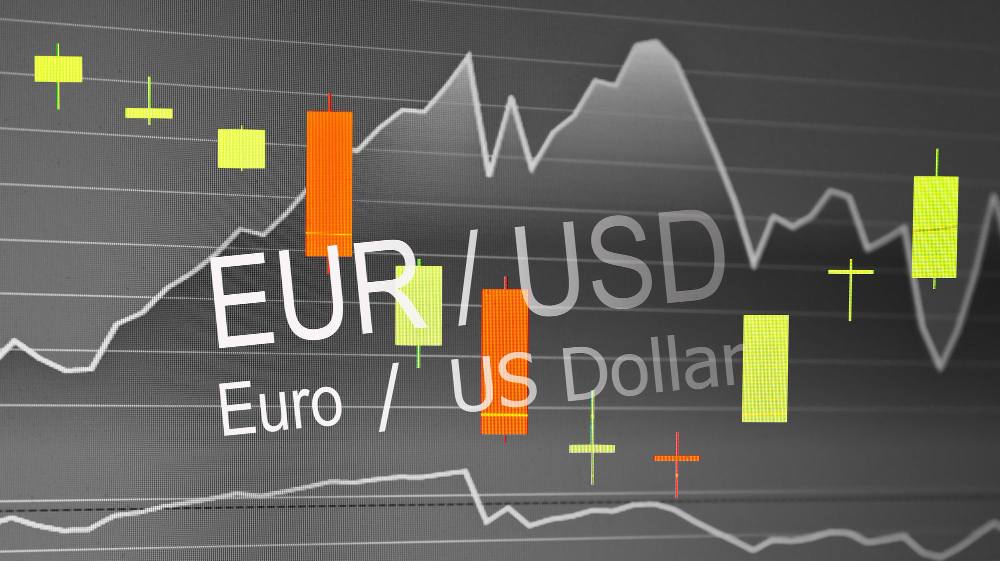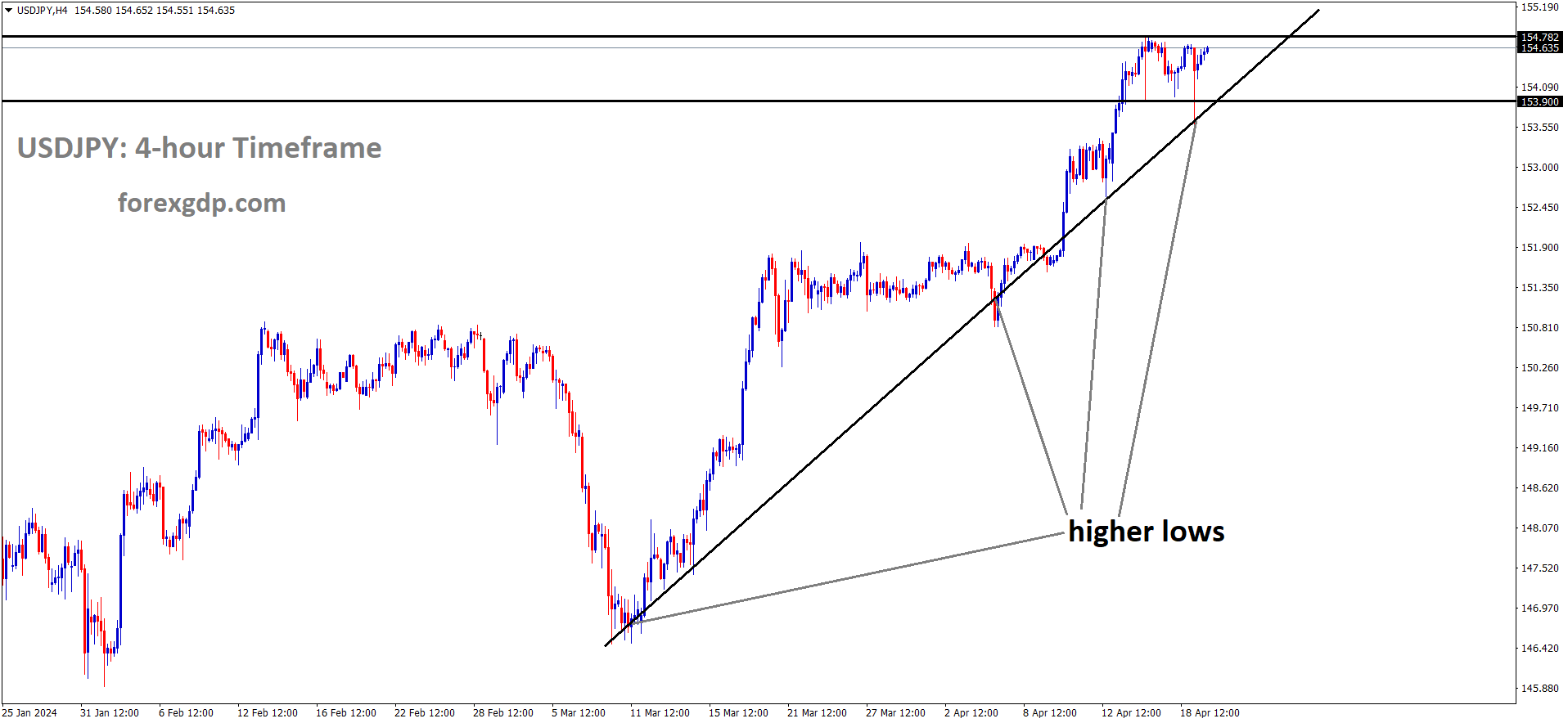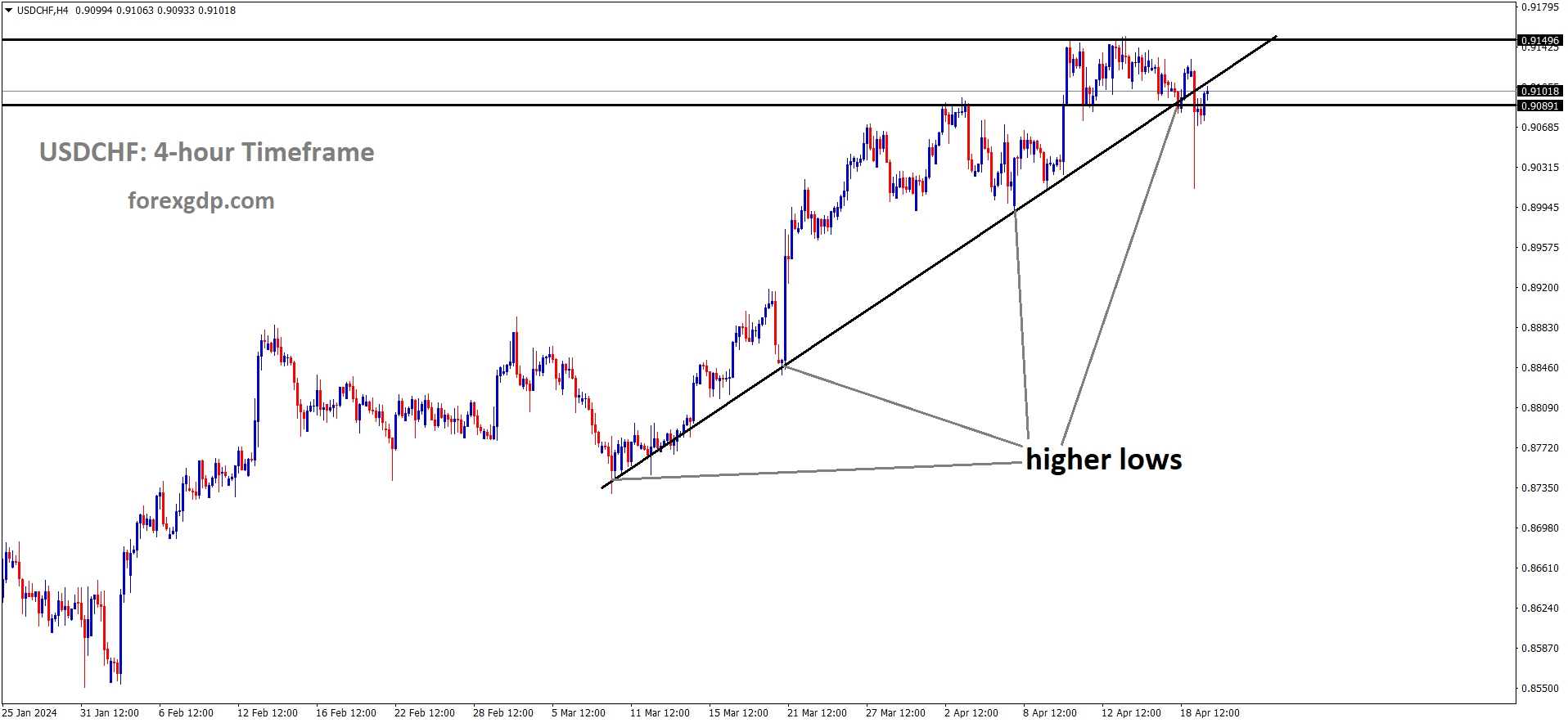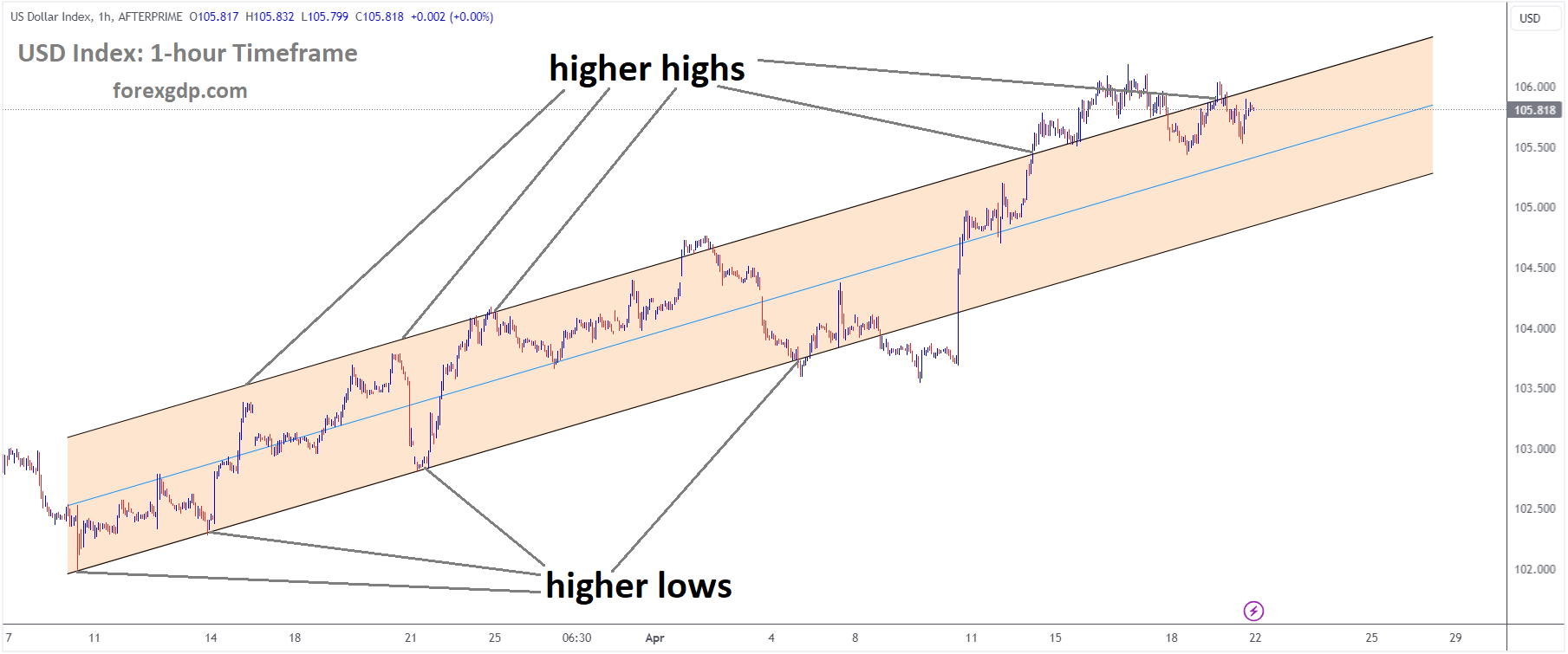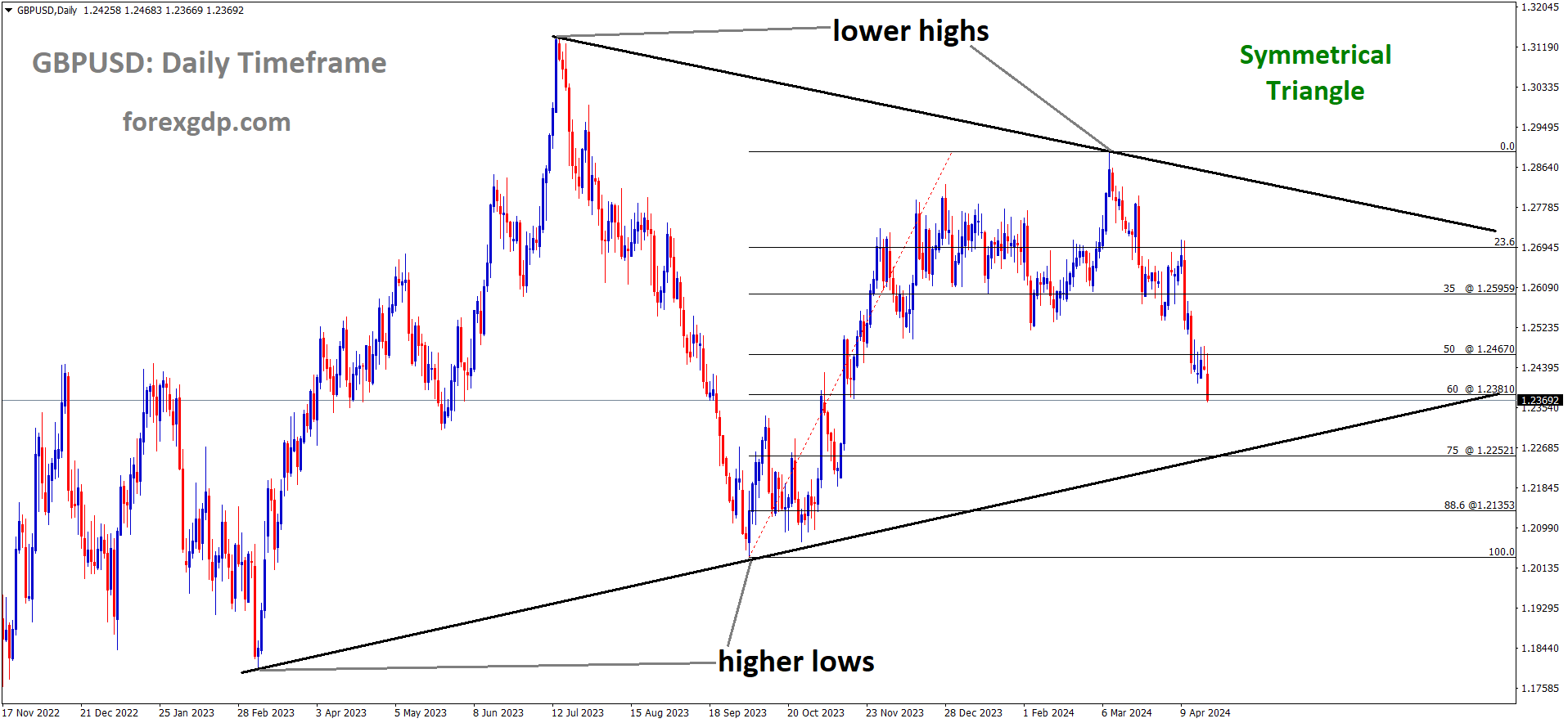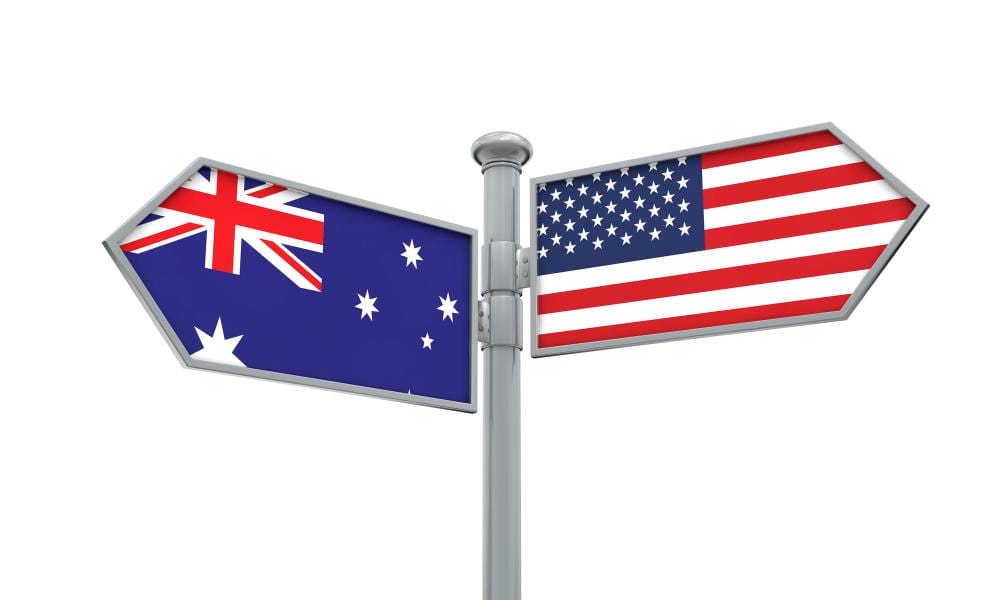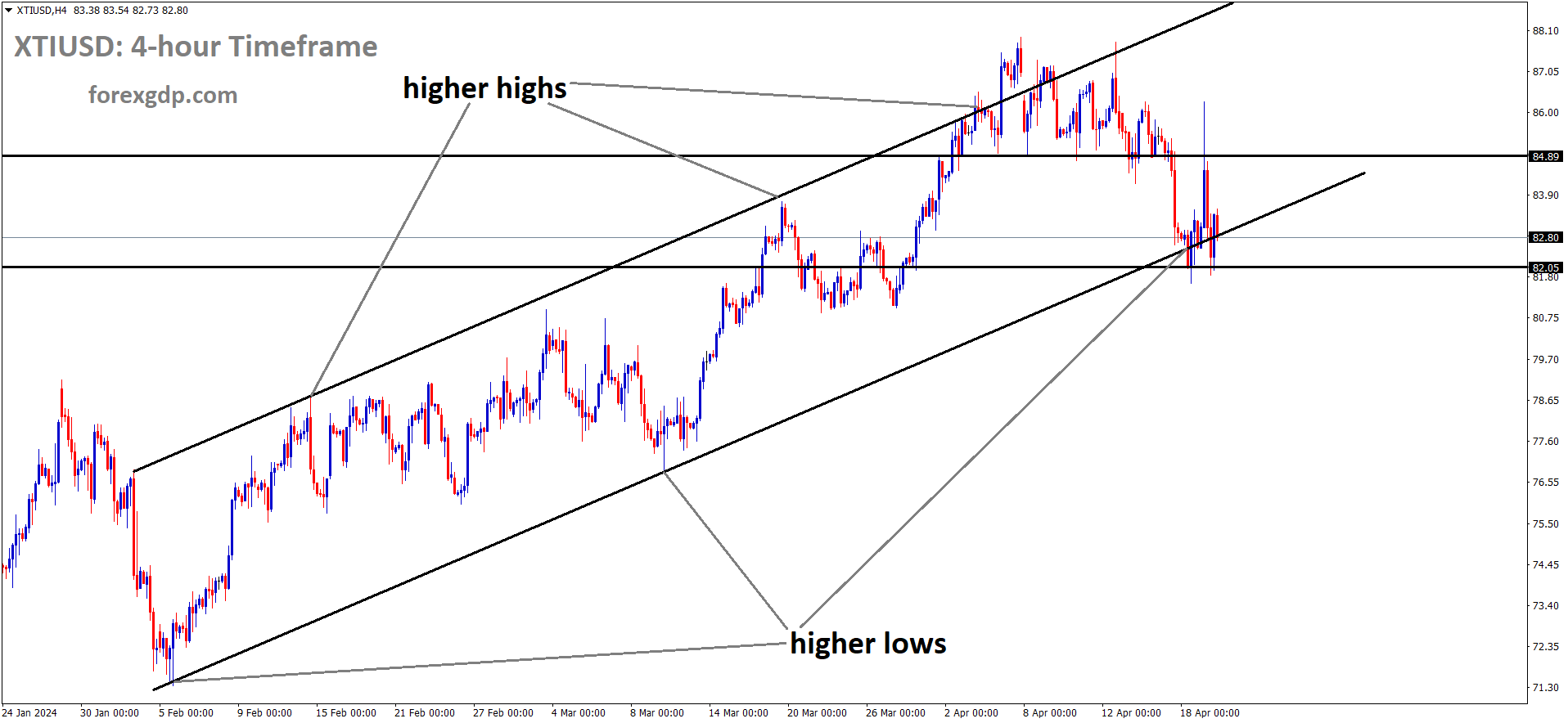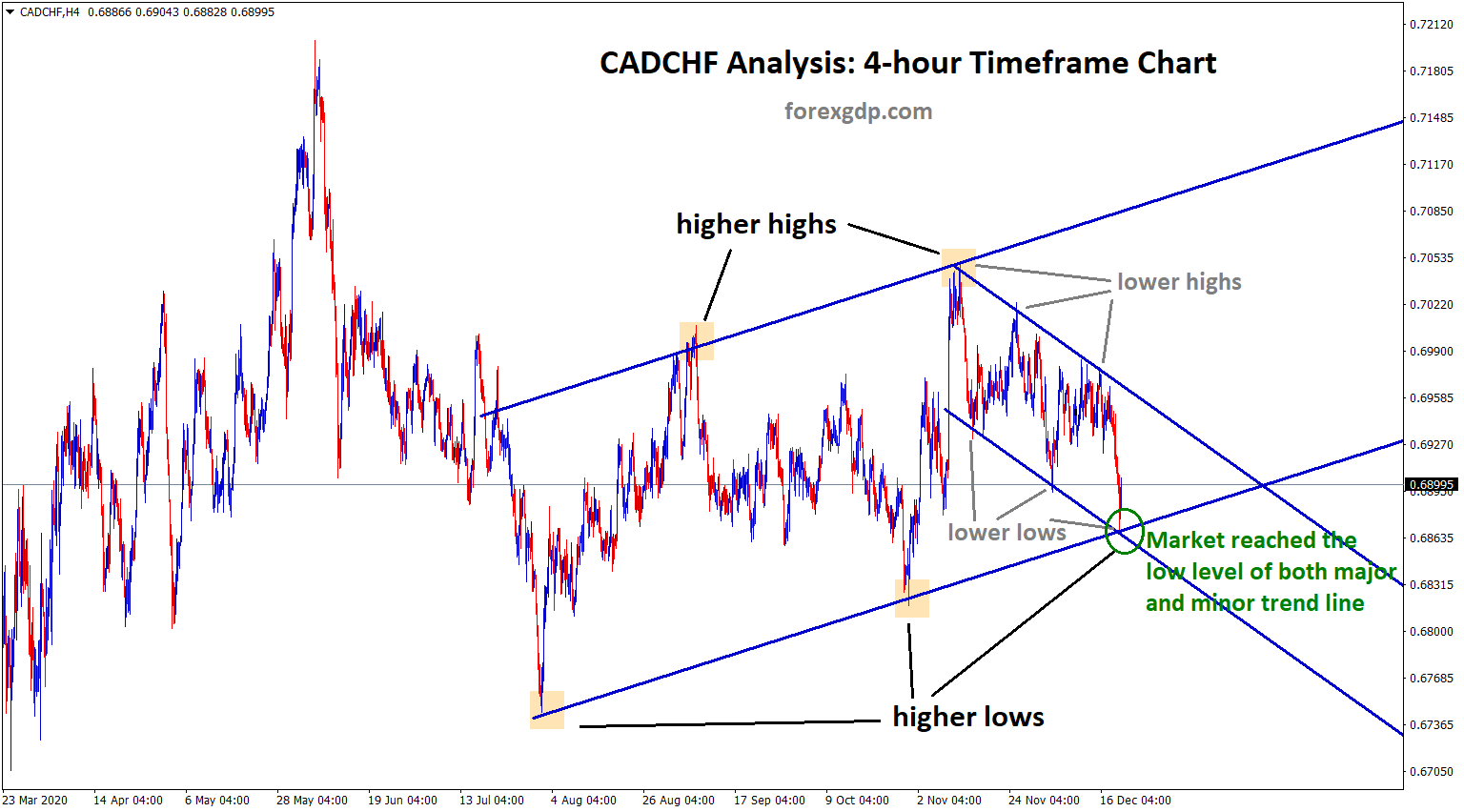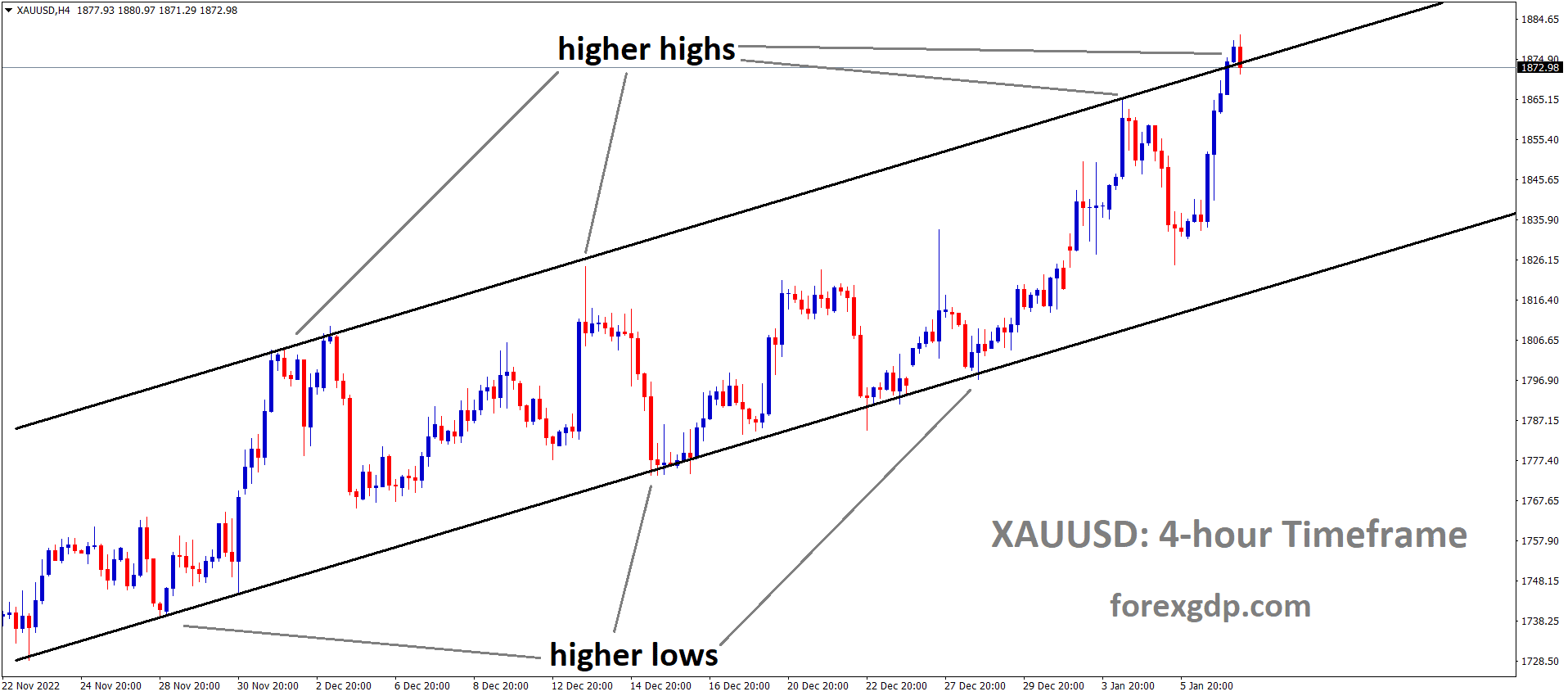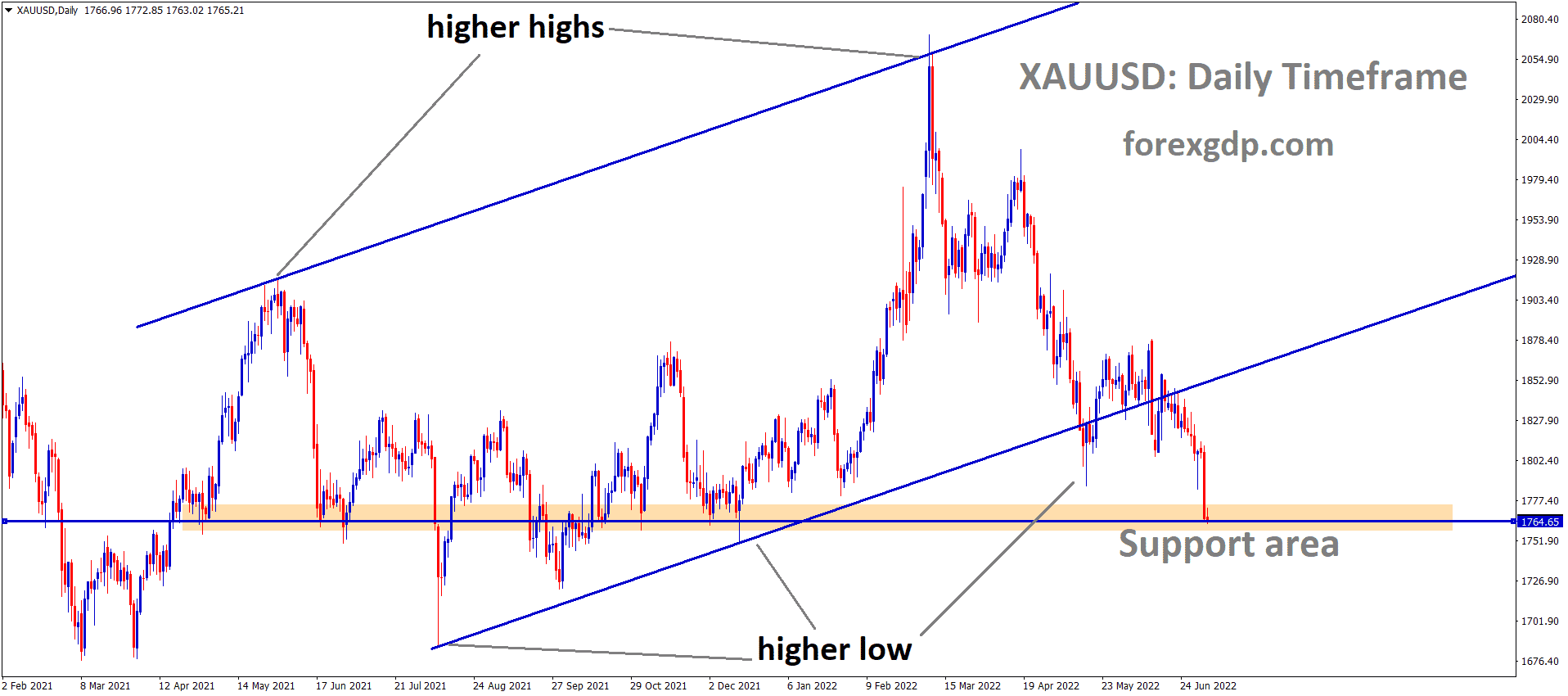XAUUSD – Gold Prices End Week Higher Amid Geopolitical Tensions, Just Below $2,400
The Gold prices are closed above $2400 this week shows the Geopolitical tensions between Iran and Israel is extended to next week is possible. FED Members continuously reiterated the hawkish comments on rate hold and inflation will be staying higher for longer time.
XAUUSD is moving in Ascending channel and market has reached higher low area of the channel
Gold prices reached a five-day peak surpassing the $2,400 mark amid escalating tensions in the Middle East, particularly between Israel and Iran. On Friday, an Israeli strike on Iran propelled bullion prices toward a high of $2,417 per troy ounce as investors sought safety amidst the uncertainty surrounding the conflict. However, the rally was short-lived as Tehran announced it had no intentions of retaliating.
As of the latest trading session, XAU/USD was trading at $2,394, marking a gain of 0.70%. Gold prices experienced significant volatility, swinging $44.00 as traders analyzed the developments from Friday. Despite recent hawkish remarks from Federal Reserve (Fed) officials, including a shift to a more neutral stance due to perceived stall in the disinflationary process, gold remained buoyant. This resilience is attributed to the decline in US Treasury bond yields and the weakening of the US Dollar.
Chicago Fed President Austan Goolsbee, previously considered dovish, altered his stance by acknowledging that inflation progress had stalled and advocated for the Fed’s current restrictive policy. This sentiment was echoed by Atlanta Fed’s Bostic and New York Fed’s Williams, both emphasizing a data-dependent approach to monetary policy, with Bostic even suggesting no rate cuts until the end of the year.
Throughout the week, gold prices were supported by geopolitical tensions in the Middle East following Iran’s attack on Israel, leading to weekly gains exceeding 2.25%. Meanwhile, the 10-year Treasury benchmark rate rose by 8 basis points to 4.615%, alongside a similar increase in US real yields to approximately 2.215% by week’s end.
Key data releases during the week, such as strong US Retail Sales figures, prompted a repricing of interest rates, with the US 10-year note yield reaching levels last seen in November 2023. Despite the robust Industrial Production data for March and positive job market indicators, concerns arose over the housing market’s unexpected weakness.
Fed officials remained vigilant on inflation, with Bostic highlighting its persistence and reiterating the Fed’s reluctance to reduce rates. New York Fed President John Williams emphasized data dependency and the adequacy of current monetary policy, signaling a cautious approach towards rate hikes.
Market expectations, as reflected in the CME FedWatch Tool, suggested a possibility of the first rate cut occurring in September, with a 67% chance of a quarter percentage point cut, slightly up from the previous day.
The US Dollar Index (DXY), tracking the dollar’s performance against a basket of currencies, marginally declined by 0.05% to 106.15.
EURUSD – Stabilizes, Faces Resistance Below 1.0700
The ECB President Christine Lagarde said in recent conference meeting, rate cuts are most probably in the June month, ECB members are mostly said in this June month due to inflation is near to our 2% target. So Policy Divergence between FED and ECB makes Euro currency weaker against USD.
EURUSD is moving in Descending Triangle
Throughout this week, Euro bears have encountered support around the 1.0605 level, preventing further downward movement in the EUR/USD pair. Despite this, the pair has largely traded sideways, with any attempts at upside movement restricted below the 1.0690 mark. As a result, the pair is poised to conclude the week with minimal changes, following a notable 1.8% decline in the preceding week.
The Euro found some respite on Friday as the US Dollar softened slightly, although the overall bearish trend remains intact. The contrasting monetary policy outlooks between the European Central Bank (ECB) and the Federal Reserve (Fed) are anticipated to exert downward pressure on the pair.
Recent data releases this week have reinforced the notion of a steady trajectory in the US economy, which bolsters the case for the Fed’s hawkish stance. Earlier on Friday, Chicago Fed President Austen Goolsbee emphasized that progress on inflation has stalled and that achieving the 2% target may take longer than anticipated. Consequently, the Dollar experienced a modest uptick in response.
In contrast, ECB President Lagarde hinted at the likelihood of interest rate cuts in June. This stance places the European Central Bank in the uncommon position of taking action ahead of the Fed, which is anticipated to weigh on the Euro and keep it under pressure.
USDJPY – Roller-Coaster Ride Driven by Geopolitical Risk
The Japanese Yen moved higher after the Israel attacked on Iran last day. But Iran said no immediate retailiation on Israel because no nuclear sites were affected by this attack. So JPY again weakness against Counter pairs after the fears of war situation come down. Inflation in the March month came at 2.7% versus 2.8% printed in the February month. But BoJ Governor Ueda sent hawkish tone on rate hikes if Yen depreciated inflation rises then we do rate hikes.
USDJPY is moving in Ascending trendline and market has rebounded from the higher low area of the pattern
USD/JPY is currently trading in the 154.50s on Friday, having initially dipped to a low in the 153.00s earlier in the day. This decline was spurred by a surge in safe-haven demand, particularly favoring the Japanese Yen (JPY), amidst escalating tensions in the Middle East.
The spike in safe-haven demand followed reports of bomb explosions in Iran, believed to be orchestrated by Israel in retaliation for Iran’s drone armada sent on April 13. While the US Dollar also saw some benefit from the flight to safety, the JPY experienced a more significant boost in demand, resulting in downward pressure on the USD/JPY pair, which indicates the number of Japanese Yen required to purchase one US Dollar.
Subsequently, as tensions began to ease, the pair saw a rebound. A senior Iranian official reportedly stated that Iran currently has no immediate plans for retaliation, as reported by Reuters.
Inflation Data and Hawkish Rhetoric from the Bank of Japan
Turning to economic data, the Japanese National Consumer Price Index (CPI) for March revealed a year-over-year increase of 2.7%, slightly lower than the 2.8% rise recorded in February, according to the Japan Statistics Bureau.
Despite the slight decline in inflation indicated by the data, the Governor of the Bank of Japan (BoJ), Kazuo Ueda, adopted a hawkish tone, which further supported the Japanese Yen. Ueda suggested that the central bank might contemplate raising interest rates once again if significant declines in the Yen lead to currency-related inflation, as reported by Reuters.
USDCAD – CAD Strengthens as USD Weakens Amid Diminished Risk Aversion
The Iran shows no retaliation on Israel drone attacks in its Nuclear site makes Calm for World markets and Canadian Dollar to move upside last day. FED Members said the rate cut in this year is very rare due to inflation will sustain longer in the US Economy.
USDCAD is moving in Ascending channel and market has fallen from the higher high area of the channel
The Canadian Dollar (CAD) has continued its ascent for the third consecutive trading session on Friday, marking a modest weekly recovery following a pronounced sell-off over the preceding two weeks. The CAD’s upward trajectory is supported by a weaker US Dollar, attributed to the absence of significant macroeconomic data releases and diminishing concerns regarding the Middle East conflict.
Investor sentiment reflects an increasing acceptance of the likelihood that the Federal Reserve (Fed) will delay and potentially reduce the scale of its monetary easing measures. This perception is prompting some profit-taking in the US Dollar. Despite comments from Chicago Fed President Austen Goolsbee highlighting the lack of progress on inflation, the impact on the US Dollar has been marginal.
Moreover, Iranian authorities have downplayed rumors surrounding a potential drone attack by Israel. With no imminent threat of escalation in the conflict, market apprehension has gradually subsided, benefiting the CAD.
In the realm of market movements, the daily digest indicates further appreciation of the Canadian Dollar, supported by a sparse US macroeconomic calendar and easing geopolitical tensions.
Chicago Fed President Austen Goolsbee’s remarks on the stagnant progress of US inflation, while expressing confidence in eventually reaching the 2% core target, have contributed to market sentiment.
Recent US economic data portrays sustained economic growth alongside a tightening labor market, reinforcing the notion that the Federal Reserve will likely maintain a restrictive monetary policy stance for an extended period.
Meanwhile, Canadian data reflects a softening trend in inflationary pressures, underscoring the contrasting monetary policy outlook between the Bank of Canada (BoC) and the Fed.
Market expectations for a Fed rate cut in July have diminished, dropping to 38% from approximately 50% at the start of the week. Investors are now pricing in 40 basis points of cuts in 2024, down from the 150 basis points projected in January. This shift in expectations reflects evolving perceptions of the future trajectory of US monetary policy.
USDCHF – Rebounds from 0.9075 Support After Fed Golsbee’s Remarks
The Chicago FED President Austan Goolsbee said inflation is the long way to come down and rate cuts is not necessary at this year. Data dependant approach for monetary policy is needed, surrounding geopolitical tensions inflation is very rare to come our target of 2%.This sentence makes US Dollar stronger against Swiss Franc. Iran retailiation on Israel attack on Yesterday is calm down and no escalation from Iran as per told by Iran Military officials.
USDCHF is moving in Ascending trend line and market has reached higher low area of the pattern
The US Dollar has managed to recover from previous losses amidst reports of an Israeli attack on Iran, which bolstered demand for the safe-haven Swiss Franc (CHF). Consequently, the USD/CHF pair has stabilized within previous trading ranges, hovering above the 0.9075 resistance level.
Chicago Fed President Austen Goolsbee’s remarks on Friday further influenced market sentiment. Goolsbee reiterated concerns about the lack of progress on inflation and emphasized the data-dependent approach in determining future monetary policy decisions. Following these comments, the US Dollar experienced a modest uptick in trading activity.
Underlying fundamentals continue to provide support for the US Dollar, with the Federal Reserve expected to maintain high interest rates for an extended period. In contrast, the Swiss National Bank (SNB) has already implemented rate cuts and is anticipated to further reduce rates later this year. This divergence in monetary policy outlooks between the two central banks favors the US Dollar, contributing to its resilience in the currency markets.
USD INDEX – USD Ends Friday in Decline but Secures Weekly Gain
The US Dollar index is moving higher after the Israel launched the tit for tat attack on Iran last day.FED Members continuously said Hawkish tone on rate hikes and inflation will not come to our target of 2% in the near term. So FED rate cut is expected in September month rather than July month polls.
USD Index Market Price is moving in Ascending channel and market has reached higher high area of the channel
Moreover, the outlook for the Greenback remains optimistic, fueled by escalating tensions in the Middle East and bullish speculation regarding the Federal Reserve’s (Fed) monetary policy, which may stimulate renewed demand for the USD.
The US economy continues to demonstrate robust growth accompanied by persistent inflationary pressures. This has prompted the Fed to adopt a more hawkish stance in its messaging, leading to a rally in US Treasury yields and consequently bolstering the US Dollar.
Key market movements observed in the daily digest include a slight correction in the DXY, although the overall sentiment remains positive, driven by elevated geopolitical tensions in the Middle East, fostering a risk-off sentiment across global markets. Furthermore, strong fundamentals combined with hawkish rhetoric from the Federal Reserve contribute to the ongoing uptrend in the US Dollar.
Ahead of the upcoming Fed meeting, indications suggest that some officials are contemplating potential rate hikes, marking a significant departure from previous intentions of rate cuts. This shift in policy stance could have substantial implications for financial markets, particularly if market pricing adjusts to accommodate this new direction.
In the US Treasury bond market, yields across various maturities, including the 2-year, 5-year, and 10-year bonds, have seen a decline. Despite this decline, yields remain near multi-month highs, with the 2-year yield trading at 4.97%, the 5-year at 4.65%, and the 10-year at 4.60%.
Market expectations now anticipate that the first rate cut may be postponed beyond the May, June, and July meetings, potentially materializing in September. This shift in expectations underscores the evolving dynamics within the financial landscape, influenced by both domestic economic factors and global geopolitical developments.
GBPUSD – Falls on Mixed UK Retail Sales, Risk Aversion
The GBP moving weaker against USD after the UK retail sales data came lower than expected last day. Retail sales data for the month of March came at 0.0% versus 0.30% rise expected and 0.10% printed in the February month. So BoE is expected to do rate cuts in the August month due to Domestic data is cooling after the rate hikes in the economy.
GBPUSD is moving in Symmetrical Triangle and market has fallen from the lower high area of the pattern
During the mid-North American session, the Pound Sterling experiences a notable decline against the US Dollar amidst a day marked by volatility, largely influenced by the escalating Israel-Iran conflict. Central bank speakers, particularly from the Bank of England (BoE) and the Federal Reserve (Fed), continue to shape the tone of the financial markets. At the current moment, the GBP/USD pair is trading at 1.2376, reflecting a decrease of 0.48%.
The GBP/USD Pair Slips Amidst Escalating Israel-Iran Conflict
As reported by Reuters, explosions were observed over an Iranian city on Friday, speculated to be the result of an attack by Israel. However, Iranian authorities downplayed the incident, asserting that they have no intentions of retaliating. Consequently, the GBP/USD pair experienced a downward trajectory, reaching 1.2388, marking a new five-month low, before managing to recover some lost ground.
Comments from the BoE’s Deputy Governor Dave Ramsden failed to provide support for the Cable, as the pair refreshed five-month lows at 1.2372. Ramsden acknowledged the potential implications of Forex movements on inflation, indicating that the bank would act in accordance with its mandate. He noted the expected challenges in the disinflation process, with risks tilted towards the downside.
Furthermore, remarks from Chicago’s Fed President Austan Goolsbee, adopting a neutral stance, contributed to a slight boost in the US Dollar. Goolsbee highlighted that progress on inflation has stalled, suggesting that a temporary pause would allow for incoming data to shed light on the disinflationary process.
In terms of economic data, British Retail Sales exhibited signs of stagnation during the European session in March compared to the previous month. Analysts had anticipated a 0.3% month-on-month growth in sales, which remained flat at 0%, while core sales experienced a decline from 0.3% to -0.3%. On an annual basis, the Office for National Statistics (ONS) reported a 0.8% increase in sales, a notable improvement from the -0.3% drop recorded in February.
AUDUSD – Maintains Rebound Above 0.6400 Amid US Dollar Decline
The Middle east tensions are eased after the Iran military officials said there is no damage to their Nuclear sites in Isfahan, So there is no retaliation from their side. This situation calm down the markets and Australian dollar rebounded from the lows. The Australian Employment data came at lower than expected makes boost for RBA to do rate cuts in the earlier in the 1st half of 2024.
AUDUSD is moving in Symmetrical Triangle and market has reached higher low area of the pattern
The Australian Dollar (AUD) experiences a recovery phase as concerns over further escalation in tensions in the Middle East ease. Reports from Iran indicate that the recent drone attack did not inflict damage on nuclear facilities in Isfahan, while the purported attack from Israel, though unconfirmed by Israel itself, appears to have been of limited scope. Furthermore, Iran has stated that it currently has no immediate plans for retaliation.
Market sentiment sees a positive shift as risk appetite improves. This sentiment is reflected in the buying interest observed in the S&P 500 at the market open, leading to a recovery from losses incurred during the European session. Despite this, 10-year US Treasury yields decline to 4.62%, even as Federal Reserve (Fed) policymakers advocate for higher interest rates over an extended period.
Fed policymakers justify their stance by citing robust labor demand and increasing wages. However, they express concern that progress towards inflation reaching the 2% target is slower than anticipated.
The US Dollar Index (DXY) experiences fluctuations around the 106.00 mark as the demand for riskier assets gains traction. Despite this short-term volatility, the near-term outlook for the US Dollar remains positive, supported by optimistic economic prospects in the United States.
On the other hand, weak Australian Employment data for March fuels speculation of potential rate cuts by the Reserve Bank of Australia (RBA). According to the Australian Bureau of Statistics, employers shed 6.6K jobs, contrary to expectations of a gain of 7.2K jobs. While February’s employment figures were slightly revised upward to 117.6K from 116.5K, the Unemployment Rate rose to 3.8% from 3.7%, albeit remaining below the anticipated rate of 3.9%.
NZDUSD – Holds Key Support at 0.5860
The NZ Dollar moved from lows after the Geopolitical tensions are calm down, NZ Q1 CPI data came at 0.60% in the March month when compared to 0.50% printed in the last quarter. The Global central banks believed that rate cuts is not necessary at current time due to inflation readings are higher. So RBNZ is expected to do rate cuts in the November month is more possible.
NZDUSD is moving in Symmetrical Triangle and market has reached higher low area of the pattern
The New Zealand Dollar (NZD) experiences a rebound as demand for riskier currencies gains traction, driven by concerns raised by economists regarding persistent global inflation. This has led to speculation that central banks, apart from the Federal Reserve (Fed), may delay their plans for interest rate cuts to prevent a resurgence in inflationary pressures. Initially, it was anticipated that only the Fed would initiate interest rate reductions later in the year due to stubbornly high inflation levels and strong labor market conditions.
Market participants foresee the Reserve Bank of New Zealand (RBNZ) shifting its stance towards rate cuts starting from November, particularly after New Zealand’s first-quarter inflation data matched expectations. Inflationary pressures rose by 0.6%, in line with estimates and higher than the previous reading of 0.5%.
Meanwhile, the US Dollar Index (DXY) experiences a slight decline to 106.10. Despite this, the near-term outlook for the US Dollar remains robust, as the Federal Reserve (Fed) maintains its stance on keeping interest rates elevated for a considerable duration to facilitate a sustainable return of inflation to the desired rate of 2%. Presently, traders anticipate the Fed to commence interest rate reductions starting from the September meeting.
CRUDE OIL – Oil Holds Firm Near Weekly Low as Markets Ease Tension Premium Amid Middle East Uncertainty
The Iran shows no retaliation on Israel drone attacks in its Nuclear site makes Calm for World markets and Oil prices are to move Downside last day. FED Members said the rate cut in this year is very rare due to inflation will sustain longer in the US Economy. There is no immediate measure from Iran is not possible at this situation makes calm for world markets and Oil prices.
XTIUSD is moving in Ascending channel and market has reached higher low area of the channel
Oil prices are experiencing a decline as market participants reassess the perceived risk level, which initially escalated following Israel’s retaliatory strike against Iran, targeting locations in the Western part of the country. This development, confirmed by two US officials speaking to Bloomberg, has prompted a shift in market sentiment, leading to a perception of reduced risk. Iran, in response, has restricted its airspace and, together with the United Nations nuclear watchdog, affirmed that no nuclear facilities were impacted by the attack. While this retaliatory action adds to the potential for direct confrontation between Israel and Iran, after years of proxy conflict between the two nations, the situation remains fluid.
Amidst these developments, the US Dollar is witnessing a partial retracement of the significant inflow of safe-haven demand seen earlier. However, the fundamental landscape remains largely unchanged. Investors continue to seek refuge in safe-haven assets amidst concerns that the recent attack could serve as a tipping point, potentially escalating tensions across the Middle East. Additionally, the Greenback is benefiting from the recent surge in energy prices, particularly crude oil, which could contribute to inflationary pressures in the coming months if the situation persists. This dynamic creates potential for another interest-rate hike from the US Federal Reserve (Fed), although it is not the baseline scenario for most Fed officials.
Currently, Crude Oil (WTI) is trading at $82.23, while Brent Crude is at $86.58.
Oil News and Market Movements: Heading Towards a Calm Weekend
According to Iran state media, an attempted Israeli drone attack has failed, and Iran currently has no immediate plans to retaliate against Israel, as reported by Reuters, citing a senior Iranian official. However, uncertainty remains regarding the timing of any potential retaliation.
Stephen Dainton, head of investment bank management at Barclays, suggested to Bloomberg that the decline in oil prices may be occurring as markets digest the latest headlines. However, he anticipates that oil will trade within a higher range going forward and may not fall below $80 in the near future.
The US Embassy in Jerusalem has issued a security alert for government officials and their families, Reuters reports.
Iran’s state television communication appears to downplay the severity of the situation, describing the attacks as minor. However, The New York Times reported comments from three Iranian officials indicating that a military air base near the city of Isfahan was indeed targeted in the attack.
Meanwhile, Israeli Prime Minister Benjamin Netanyahu faces criticism from his National Security Minister Itamar Ben Gvir, who characterized the attack as “weak” in a tweet.
Don’t trade all the time, trade forex only at the confirmed trade setups
Get more confirmed trade signals at premium or supreme – Click here to get more signals , 2200%, 800% growth in Real Live USD trading account of our users – click here to see , or If you want to get FREE Trial signals, You can Join FREE Signals Now!





